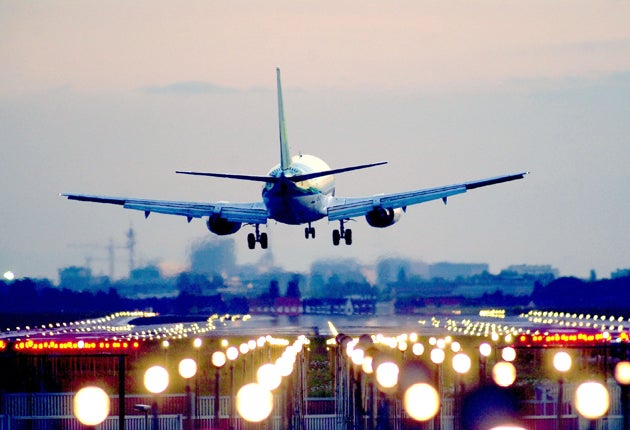Last Night's Television - The Secret Life of the Airport, BBC4; The Wire, BBC2
Flight of their lives

The actor Philip Glenister, of Life on Mars and Ashes to Ashes, narrates The Secret Life of the Airport, which in last night's programme seemed fitting, for it was nothing if not an exercise in time travel, whisking us back to the days when 14 days on the Costa Brava, all-inclusive, cost a curiously un-round £46.13.
I confess that I approached this series with trepidation, expecting another airport docusoap littered with "meanwhile, Dipak the baggage handler is having a hard day" or "over at immigration control, Roderick is experiencing a spot of bother with a sniffer dog". But it isn't like that at all. It's an exemplary documentary about the growth of airports, based on yards of interviews and a really good rummage through the archive bin. Last night, we were treated to newsreel footage of the young Queen Elizabeth opening the first permanent terminal at London Airport, with that royal enunciation that never quite made it into the colour-television age, which had her "stending on the edge of the old world, looking towards the new".
That was in 1953, just after the development of the commercial jet aircraft had dramatically broadened the horizons of international travel, and with it the potential of airports, which would end up almost as self-contained cities, with, as one contributor slightly fancifully put it, the control tower as the cathedral spire, the departure lounge as the main street, and the baggage halls as the industrial zones. One woman, brought up near Heathrow, as it was eventually renamed, used to base her social life there. After all, it was (and possibly still is) the only place in the Staines area where you could buy a cup of coffee at midnight. Similarly, my wife Jane and her sister Jackie used to think it an enormous treat, in their 1960s South Yorkshire childhood, when their parents took them for tea at the newly built Woodall service station on the M1, not as part of a motorway journey, but as a destination in its own right. No wonder our own kids refer to our childhoods, without a shred of irony, as "the olden days".
Anyway, with the development of the Comet 4 aircraft in 1958 came non-stop transatlantic flights, and the programme-makers managed to find a man who'd won a competition to travel on the Comet 4's inaugural service to the United States, and who remembered the plane's momentous arrival at Idlewild (later John F Kennedy) airport in New York being booed by crowds of Americans indignant that the Brits had got a commercial passenger plane across the Atlantic before they had. Not that it was a particularly affordable means of travel. The one-way fare from London to New York cost £173, which is comparable with prices now but at a time when the average weekly wage was £12.
Meanwhile, back at London Airport (denied a naff docusoap script, I have resolved to write my own), the photographer Dennis Tompkins was soon wise to the opportunities afforded by the daily arrival of TWA 760 from Los Angeles, which usually yielded at least one movie star – cue the inevitable but always-welcome archive of Marilyn Monroe, Frank Sinatra, Ava Gardner etc walking across the tarmac into a blizzard of flash bulbs. But airports didn't remain synonymous with glamour for long. When the major airlines refused to operate out of Gatwick, opened in 1958, the charter-flight and package-holiday industry was born. In 1950, only one in 50 Britons had a passport, but by 1965 it was one in 11. Gatwick's fortune was Torremolinos's ruin.
All this was engrossing stuff, expertly told if perhaps with marginally too much reliance on a seemingly arbitrary assortment of academics (note to documentary-makers, the caption "Joe Shmo, University of Nottingham" means nothing unless we are also told what Joe Shmo does at the University of Nottingham), and I am now armed with enough arcane facts and figures about airports to bore the pants off the next person unlucky enough to sit next to me on a plane. Incidentally, did you know every 10 minutes we spend in a departure lounge is worth $1 to the airport? Actually, I'm surprised it's not more, perhaps $10 for every minute. As a family of five we've normally blown a third of the holiday budget by the time we walk to the gate, just on tuna melts, coffees and Cokes.
The other kind of coke continues to loom large in The Wire, the third series of which began last night, and frankly I'm beginning to wonder whether some kind of mind-bending drug might add comprehension of what's going on out there in the mean streets of Baltimore. I can see that it's brilliantly acted, and people keep telling me to stick with it, but Jane took 10 minutes out of last night's episode to get our youngest to bed, and when she came back and asked "What's happened?" I started to explain before realising that, to all intents and purposes, I didn't have a mother****ing clue.
Subscribe to Independent Premium to bookmark this article
Want to bookmark your favourite articles and stories to read or reference later? Start your Independent Premium subscription today.

Join our commenting forum
Join thought-provoking conversations, follow other Independent readers and see their replies